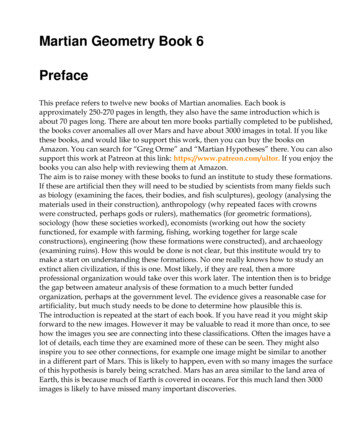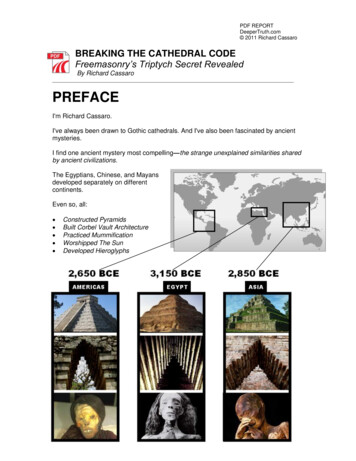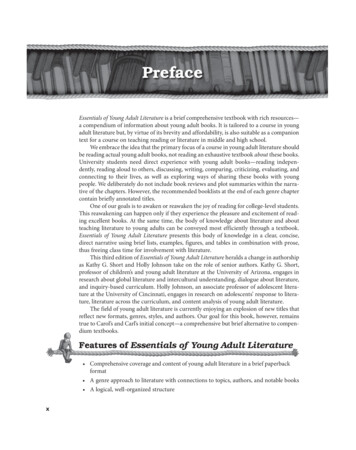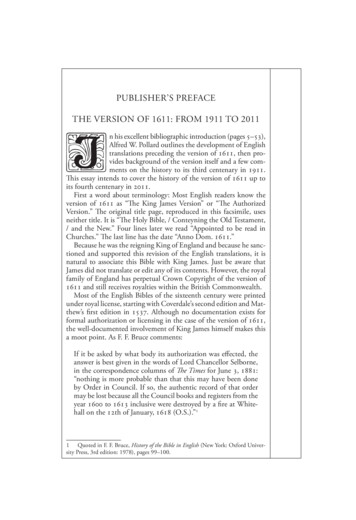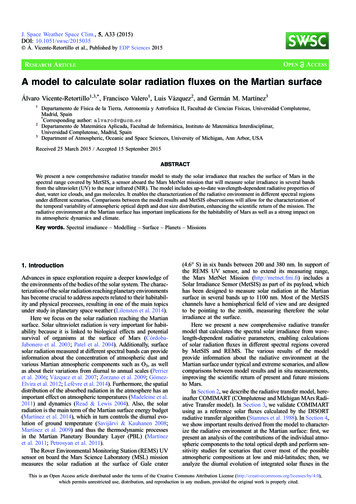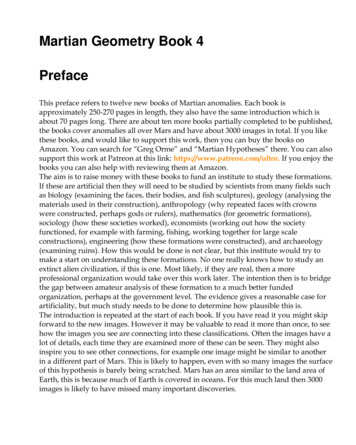
Transcription
Martian Geometry Book 4PrefaceThis preface refers to twelve new books of Martian anomalies. Each book isapproximately 250-270 pages in length, they also have the same introduction which isabout 70 pages long. There are about ten more books partially completed to be published,the books cover anomalies all over Mars and have about 3000 images in total. If you likethese books, and would like to support this work, then you can buy the books onAmazon. You can search for “Greg Orme” and “Martian Hypotheses” there. You can alsosupport this work at Patreon at this link: https://www.patreon.com/ultor. If you enjoy thebooks you can also help with reviewing them at Amazon.The aim is to raise money with these books to fund an institute to study these formations.If these are artificial then they will need to be studied by scientists from many fields suchas biology (examining the faces, their bodies, and fish sculptures), geology (analysing thematerials used in their construction), anthropology (why repeated faces with crownswere constructed, perhaps gods or rulers), mathematics (for geometric formations),sociology (how these societies worked), economists (working out how the societyfunctioned, for example with farming, fishing, working together for large scaleconstructions), engineering (how these formations were constructed), and archaeology(examining ruins). How this would be done is not clear, but this institute would try tomake a start on understanding these formations. No one really knows how to study anextinct alien civilization, if this is one. Most likely, if they are real, then a moreprofessional organization would take over this work later. The intention then is to bridgethe gap between amateur analysis of these formation to a much better fundedorganization, perhaps at the government level. The evidence gives a reasonable case forartificiality, but much study needs to be done to determine how plausible this is.The introduction is repeated at the start of each book. If you have read it you might skipforward to the new images. However it may be valuable to read it more than once, to seehow the images you see are connecting into these classifications. Often the images have alot of details, each time they are examined more of these can be seen. They might alsoinspire you to see other connections, for example one image might be similar to anotherin a different part of Mars. This is likely to happen, even with so many images the surfaceof this hypothesis is barely being scratched. Mars has an area similar to the land area ofEarth, this is because much of Earth is covered in oceans. For this much land then 3000images is likely to have missed many important discoveries.
You can also use the indexes in each book, they refer to many similar formationsthroughout them. For example, if you are looking at hypothetical road formations thenroads in many different areas can be found in the indexes. It would be possible then toquickly see all the different kinds of hypothetical roads in all 10 books. The idea behindthe introduction is to give an outline to the global hypothesis, how these differentformations connect together into a hypothetical Martian civilization. It’s important thento get an intuition of how these formations connect together globally.Some areas for example might have hypothetical roads for transport, other might havehypothetical tubes like a covered road. Different terrain, available materials, and climatemight have led to one being used over the other. It may be as Mars cooled it becamenecessary to travel under cover because of the cold. Another possibility is predators ormeteors made traveling on roads too dangerous. Also there are many hypothetical damformations, but the construction techniques vary between areas. Some are formed withdam walls attached to the crater, when they break some show a cavity under them andothers do not. This would indicate the dam wall was dug into this cavity to keep it fromsliding down the crater wall. In other areas this was not necessary, it may be that therethe crater wall was harder rock which the dam wall could be cemented to. Some showcolumns and layers in them but others have evenly spaced vertical grooves on the damwalls. Some dams are excavated out of the crater wall or the material at the bottom of thecrater, these may depend on the rock type in the crater. For example, if the crater wall istoo easily broken then an excavated dam might have been the best engineering solution.Some areas have hollow hills, these are where a hollow habitat may have been built on anexisting hill or the whole hill was constructed. In some areas these have layers similar to aCobler Dome, this is where bricks form the dome in decreasing circles as the dome isbuilt up. These are called amphitheatres as a friendly name, the first amphitheatreformation looked more like seating around an amphitheatre. Other hypotheticalbuildings have no layers in their roofs. This may have depended on the materialsavailable. Many appear to have a smooth skin like cement which has broken up in someparts of the roof, and is intact in others. In many areas this is more intact on the southernside, as the skin breaks off the softer inner parts of the roof appear to have eroded fasterand collapse. The one sided erosion may imply a prevailing wind, or as the oceans andair froze at the pole this created the erosion.There are also large areas of walls and room like shapes, these are hypothetical cities.Other areas connect these hollow hills together with tubes or roads as another kind ofhypothetical city. Still others seem to be made of tubes that connect together inintersections called a tube nexus. This may have been because of the climate further fromthe equator, for example tubes might have been used to travel through in colder areas.
The Martian Faces are mainly discussed in books 11 and 12, a reprint of published peerreviewed papers. These differ according to where they are. The Cydonia Face, Nefertiti,and King Face all fall on a great circle, this is hypothesized to have been an old equatorthat lines up with a known previous pole position west of Hellas Crater. The newlydiscovered Queen Face is in Cydonia but not near the old equator. If the faces were usedto mark latitudes and longitudes then the overall system remains obscure. For examplethere is a large hyperbola shown close to the old equator. Another is far from thisequator, but drawing a line from it to Nefertiti gives a right angle to this old equator.Joining these two hyperbolas and the King Face gives an Isosceles Triangle. Thehypothesis of these mapping system is highly speculative at this stage.Canals, lakes, and water channels also vary in different areas. West of Cydonia there is anextensive array of hypothetical canals, also east and west of Elysium Mons. Some of theseconnect to larger lakes which may be artificial. Some hypothetical dams have waterchannels to direct water into a dam, and to collect an overflow to another dam.There are also darker areas often bounded by walls or geometric shapes. These may havebeen farms, why they appear in some areas like around Cydonia and in Isidis remainsunanswered. Other areas contain hypothetical artefacts but no farm formations, so thesecreatures would have used a different way of collecting food.The idea of these books then is not just to prove artificiality, but to try to prove a globalhypothesis of how the whole civilization functioned. Once the evidence becomesplausible enough, and the shock wears off, this larger question is much more interesting.Each section is labelled with the title hypothesis to make clear these notions are beingproposed along with the evidence there. The sections all have many keywords connectingto the index. If you see a connection to a kind of formation then it is easy to find similarformations. In seeing the global hypothesis the different pieces of the puzzle are morelikely to come together, for example the hypothesis of dams sounds less plausible if it isnot connected to the hypothesis of buildings and farms. Together they give the ideas ofhabitation, food, and water. The conclusions can be controversial. However there is somuch evidence it was better to put it all together into a more comprehensive hypothesis.Otherwise people are looking at isolated formations like faces without seeing the overallcontext in which they appear.Argd1445a2
HypothesisFour parabolic dams are shown, there would be several more if the resolution was better.Argd1448HypothesisThere may be some dams here, A at 11 o’clock looks like a dam as does at 7 o’clocksecond leg. At 4 o’clock there is a double wall, like an inner and outer parabola. A showsa small dam at 8 o’clock, one at 7 o’clock, and two more at 4 and 5 o’clock. C shows moredams, D and E may be eroded dams.
Argd1448aHypothesisA parabola is shown.
Argd1453HypothesisThese are similar to the walled fields in Hellas Crater, this is in Argyre Crater so perhapsboth have a large lake. A shows some walls, B shows a walled field with the wall from 9to 11 o’clock having another wall parallel to its left. C may be more walled fields or pitdams. D also might have many segments that would hold water. E at 8 o’clock looks likea small elliptical dam. F shows a large enclosure.
Argd1454HypothesisA at 12 o’clock 3rd leg shows regular grooves in the wall, perhaps pillars as it erodes. At 7o’clock is a double wall. B shows more of these pillars between 1 and 4 o’clock, also at 5o’clock. C and D show more walls.
Argd1455HypothesisA shows a parabola, strengthening the evidence of these walls being artificial Theenclosure at A at 6 o’clock 3rdleg is also roughly symmetrical. B shows more walls.
Argd1455aHypothesisTwo parabolas are shown.
Argd1457HypothesisA shows a circular wall at 4 o’clock but this would not be a crater, a straight wall at 7 andanother at 8 o’clock. Between A and C is a double wall, at 6 o’clock a right angle. D showssome depressions that can be pit dams or collapsed hollow hills.
Argd1458aHypothesisTwo parabolas are shown, closeups of parts of this image follow. It appears to show acomplex irrigation system. The parabolic dam at B seems to have a pipe coming out of itat 12 o’clock, it also has vertical grooves on the sides at 1 o’clock like pillars. The pipegoes down to 8 o’clock connecting to a second pipe off to its left and down to E. B at 4o’clock is another pipe. C shows another parabolic dam, D at 2 o’clock is probably aparabolic arch.
Argd1458bHypothesisThis shows a closeup of the pipe, at 11 and 1 o’clock it is straight and connects aboveground level onto the dam. At B it is more eroded, to the left it connects to a second pipe.They may be regular pillars along the pipe closer to B like supports.
Argd1458cHypothesisA shows some erosion on the dam wall, at 4 o’clock there may be pillars. B shows aflaking off of the cement skin at 11 o’clock, 10 o’clock shows a cavity developing underthe dam wall. C would be a water channel and is smooth like cement, at 4 o’clock 2nd legthere is perhaps a second water channel.
Argd1458c1HypothesisA parabola fits onto this dam except for the right side, many dams have the parabolicshape in the main load bearing segment then curve differently on the sides. This is alsoan unadjusted parabola, with the standard Y x2 dimensions, many parabolic dams arenarrower than this.
Argd1458dHypothesisThis is a closeup of the dam with the pipe connected to it. A shows the top of the pipemay be hollow as if it has collapsed at 10 o’clock, at 11 o’clock there more of these pillarsor vertical grooves. They are very evenly spaced without random variations. B may showsome erosion as the dam floor cement skin peels off. C shows several layers in the damwall which appear to be progressively breaking off, D shows more erosion and cracks onthe top of the wall.
Argd1458fHypothesisA shows how the pipe at 4 o’clock reaches a junction, a second pipe at 6 o’clock goes offto the left over to B where it may enter a water storage area. There are regular marksalong the pipe like supports in it. Between B and F there may be a collapsed part of thisstorage, another between B and D. C shows more layers breaking off along this formationalong with the vertical grooves. D also shows vertical grooves at 6 and 7 o’clock, also at10 o’clock. E shows an artificial looking segment at 2 o’clock, also a water channel turninginto a pipe at 10 o’clock. F shows another dam at 7 o’clock and a pipe or cracks at 4o’clock.
Argd1458jHypothesisA shows layers in the dam wall at 8 and 5 o’clock, at 2 o’clock there is a double wall onthe first leg. The second leg points to a small water channel. B at 3 o’clock may be a smallwater storage, at 8 o’clock is a water channel. C shows another water channel andperhaps water storage or dam from 4 to 7 o’clock. D shows regular grooves in the wall at11 o’clock like pillars. At 8 o’clock there may be the end of the water channel, anotherwater channel is at 1 o’clock second leg. 2 o’clock first leg shows a layer, the second legshows a parabolic dam. E shows another dam at 7 o’clock, the smooth cement wall at 8o’clock, and an eroded water channel from 1 to 5 o’clock.
Argd1458j2HypothesisFour parabolas are shown, D at 2 o’clock second leg may also be a parabola.
Argd1462aHypothesisA shows a parabolic dam with dark soil clogging part of it, from 2 to 4 o’clock the walls ishighly eroded with dark soil in the cracks. At 7 o’clock the wall is in good condition. Bmay have been a parabolic dam, between 6 and 8 o’clock the wall appears to have broken.Water may have run here after no repairs were made with 3 flows shown at C.Alternatively these may be 3 small dams and were constructed after the broken dam wallas a repair. D shows another dam.
Argd1462a2HypothesisA parabola is shown.
Argd1462bHypothesisA shows a double parabolic dam, the second wall may be for strength or to catch anoverflow. B shows another parabolic dam with a break in the dam wall, water has createda water channel going down from it. This implies the water flowed here after the builderswere not here to repair the dam. C also shows a double walled dam. D has a double wall,F at 11 o’clock second leg shows a cavity growing under the wall perhaps leading to itscollapse. Above E is a parabolic arch, under it may be an arch as well with a dam at 7o’clock second leg. F between 12 and 10 o’clock shows vertical grooves perhaps forstrength. G may be for supporting the dam above it.
Argd1462b2HypothesisThree parabolas are shown.
Argd1462cHypothesisThe dam at A is full of silt, also the dam wall is highly eroded. The vertical grooves in itare more visible. B shows where water has leaved through the dam wall. C at 10 o’clock isprobably a buried segment of double wall, at 7 o’clock would be a buried dam. D shows adam at 6 o’clock and some cracks in the dam wall at 10 o’clock. E and F show other dams.
Argd1462b2HypothesisTwo parabolas are shown, E is probably also a parabola.
Argd1467aHypothesisThese dams are in better condition with A probably containing more silt. At 8 o’clock thetop layer edge of the dam catches the light more, above 8 o’clock there are regular markslike pillars. At 2 and 4 o’clock the dam layers are more eroded, B also shows these at 10o’clock. At 8 o’clock the vertical grooves may be for strength, also seed at 1 o’clock. Thewall is smooth like cement at 12 o’clock, some layers are seen at 2 o’clock. A shows morevertical grooves above the parabolic arch at 10 o’clock, also some layers in the dam floorat 4, 5, and 7 o’clock. D shows more pillars and another layer.
Argd1467a2HypothesisThree parabolas are shown.
Argd1467bHypothesisThese dams are more highly eroded, A, B, and C show exposed layers. D and E showlayers in the dam floors.
Argd1467b2HypothesisTwo parabolas are shown. B is probably a parabolic arch.
Argd1467cHypothesisThis segment looks like another straight pipe going underground at A at 4 o’clock, thissegment may have collapsed giving a U shaped cross section. A shows a layer or pipefrom 10 to 2 o’clock, over to B at 8 o’clock The main pipe appears to have a triangularcross section shown at B at 4 and 7 o’clock, C shows another side of it with some verticalgrooves or erosion. D shows a water channel at 6 o’clock, also another one at 7 o’clock.
Argd1472aHypothesisA and E show some erosion on the dam floors, the pale material may also be dried salts.B may show a small dam between 4 and 6 o’clock, it may also be a water channeldirecting the water to the larger dam under the two main ones. To the right of B at 3o’clock is a narrow water channel. C at 12 o’clock shows some damage on the top of thedam wall, at 2 o’clock second leg the layer in the dam wall may show the constructiontechnique used. D shows more damage to this dam wall at 9, 10, and 11 o’clock, in thisarea the dam floor is very smooth like cement. The walls at 2, 4, and 7 o’clock ae in goodcondition, it may be little water came into the lower dam. F shows the dam floor cementbreaking up at 7 o’clock, a water channel at 6 o’clock second leg, and a smooth wall at 5o’clock second leg. G at 3 o’clock may show a small dam or water channel, at 6 o’clock isthe edge of the smooth dam floor in the left dam. H shows a smooth dam wall.
Argd1472a2HypothesisTwo parabolas are shown.
Argd1474HypothesisA and B show the edges of a parabolic dam, A at 12 o’clock is probably a water channel.Bis probably cement in the dam wall breaking up, it can indicate how thick it is.
Martian Geometry Book 4 Preface This preface refers to twelve new books of Martian anomalies. Each book is approximately 250-270 pages in length, they also have the same int
